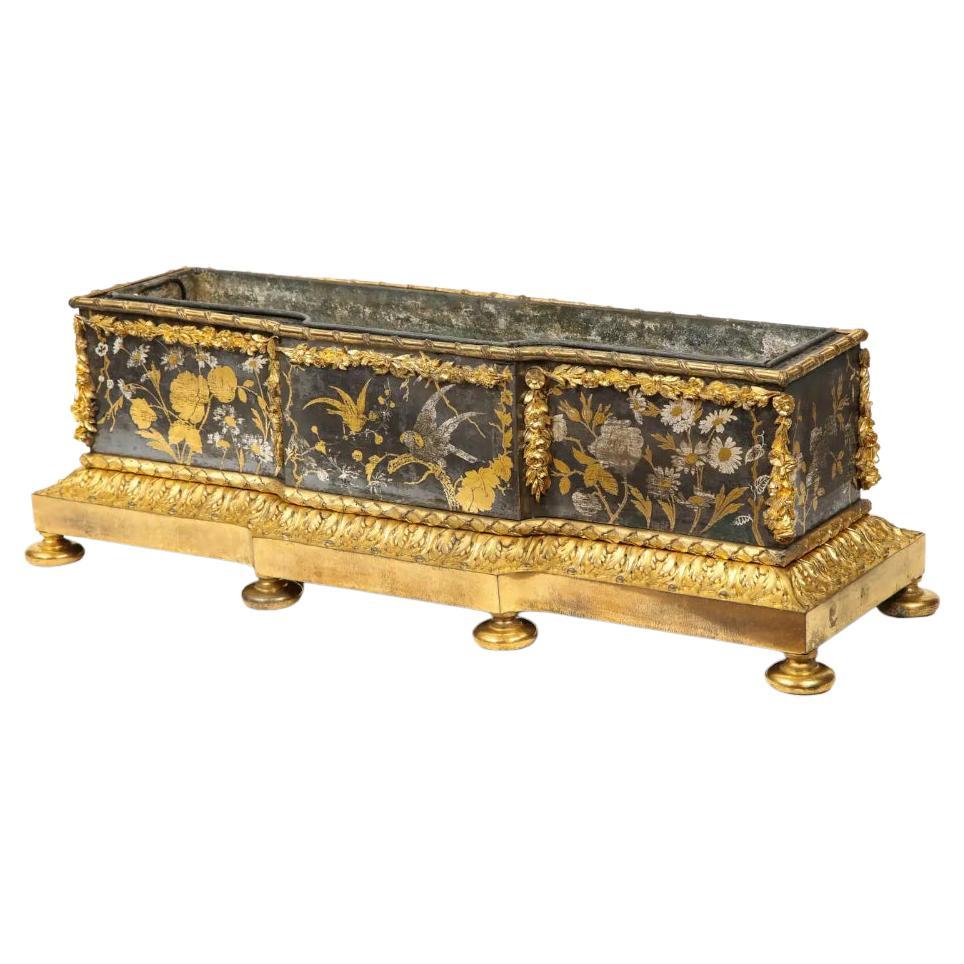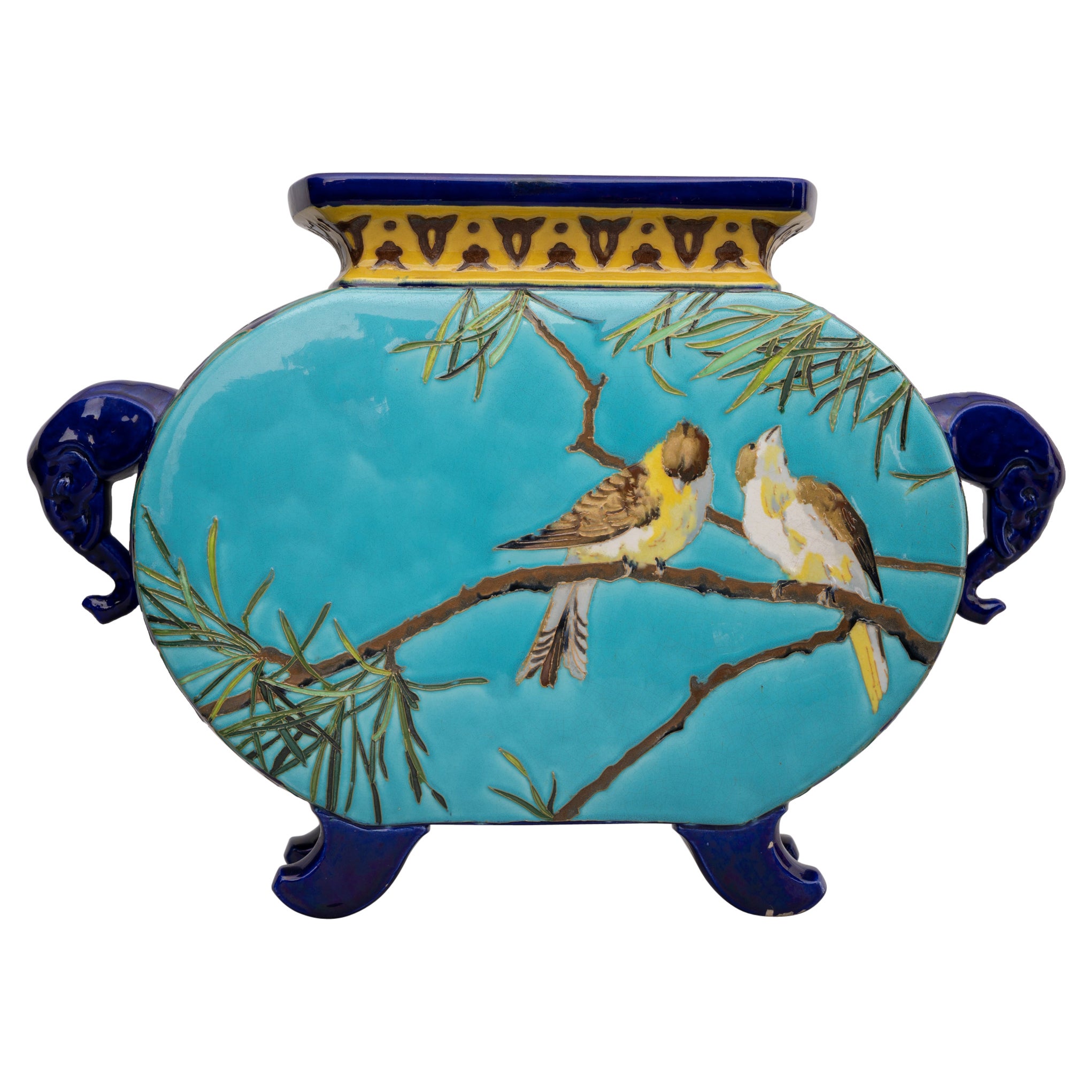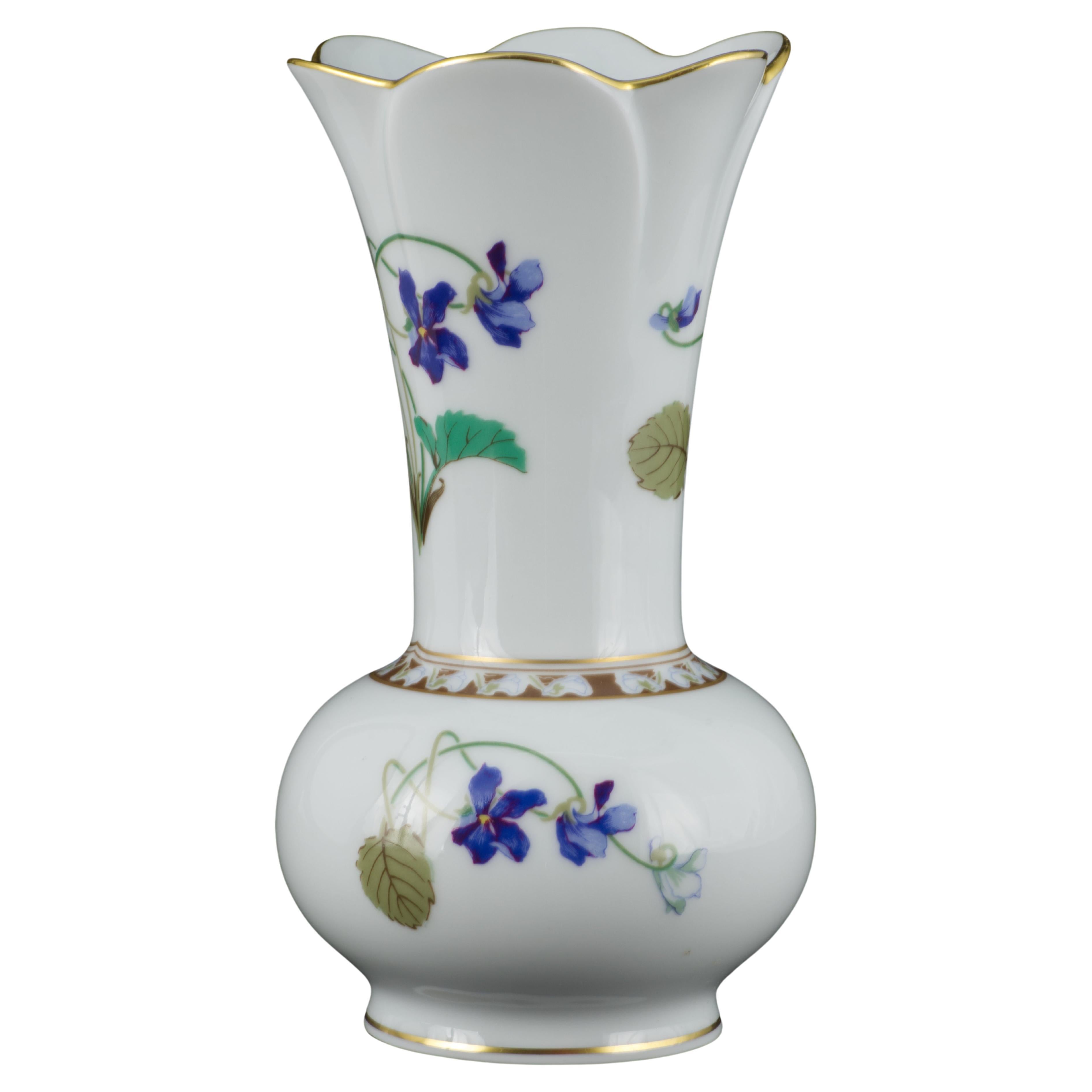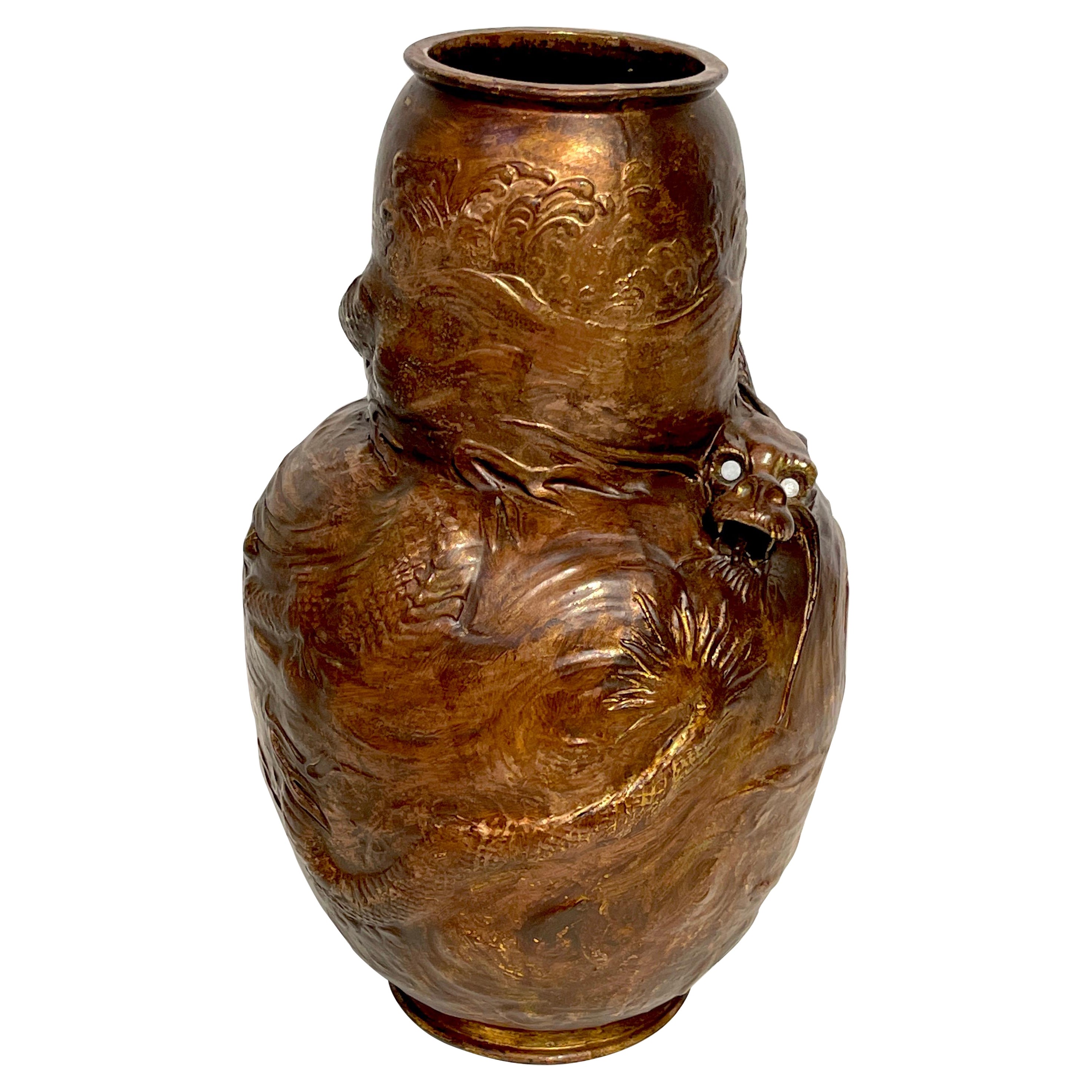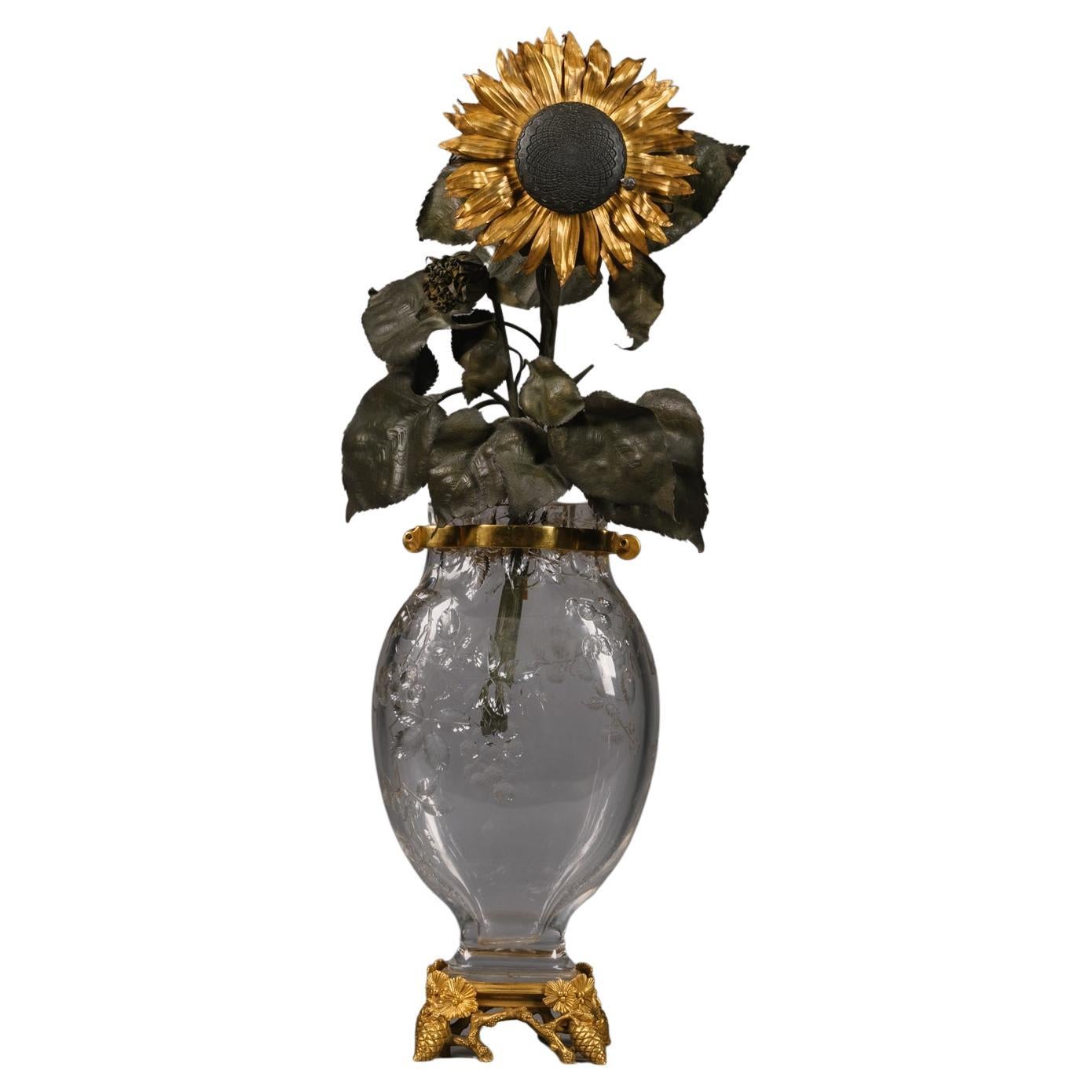Items Similar to Japonisme Jardinière by Haviland & Co att. to Alexandre Dammouse
Want more images or videos?
Request additional images or videos from the seller
1 of 7
Japonisme Jardinière by Haviland & Co att. to Alexandre Dammouse
About the Item
Japonisme stoneware and bronze jardinière attributed to Édouard-Alexandre Dammouse for Haviland & Co, with bronze mounts attributed to the F . Barbedienne foundry.
Based on the principles of the British Arts and Crafts movement, Art Nouveau artists sought to reform the decorative arts by emphasizing uniqueness and a return to craftsmanship. Artist-potters found inspiration in Asian ceramics, particularly Japanese stoneware (a hard, dense type of pottery), which was shown in 1878 at the Exposition Universelle in Paris, as well as in the forms, glazes, and techniques of Chinese porcelain and pottery. They also looked to European traditions such as the rustic salt-glazed stoneware of the sixteenth and seventeenth centuries and Gothic sculpture and architecture. In the process they created works of ceramic art that were entirely modern and new.
Origin: French, Paris
Date: Late 19th-century, Circa 1880's
Dimensions: 16in H x 17in W x 13in D
Produced by Haviland & Company - stamped with their H & Co rosary stamp on the bottom
Founded in 1864, Haviland & Co. consistently pushed boundaries in their industry under the leadership of Charles Haviland (1839-1921) and initiated a revolution in porcelain decoration in the 1870s thanks to artistic director Félix Bracquemond’s use of chromolithography on ceramics. Bracquemond also initiated collaborations with various artists including the brothers Edouard-Alexandre and Albert-Louis Dammouse, Felix Lafond, and Edouard Lindeneher, a wise decision that would bear even more impressive artistic fruit the following decade. In 1874, Haviland purchased the secrets to renowned ceramist Ernest Chaplet’s recently developed barbotine technique and, the following year, hired Chaplet to further develop the ware at the company’s experimental studio in Auteuil.
Chaplet’s reputation at Haviland was such that, when high production costs forced the company to close the Auteuil studio in 1881, he convinced the firm to open another atelier on the Rue Blomet, Vaugirard in Paris. For the next several years, Chaplet oversaw the creation of a wide variety of wares. He was an adherent to Arts and Crafts philosophies and believed strongly in fostering a creative atmosphere in which a single artisan is responsible for both the design and execution of an object. Similar to Bracquemond before him, Chaplet collaborated with about 20 artists, chief among them the Dammouse brothers and Ringel d'Illzach, with whom he produced stoneware and experimental porcelain. The resulting vases and sculptures ranged from red-brown stoneware with incised Japonesque decoration, colored slips, enamels, and gilding, to oxblood-glazed porcelain vases and figurines.
Beyond his leadership and collaborative efforts, it was at the Vaugirard studio that Chaplet—with chemist Lebrun de Rabot—finally succeeded in reproducing the elusive sang-de-boeuf (oxblood) glaze he had seen on medieval Chinese ceramics. In 1886, economic difficulties forced Haviland to cease production at all locations except his Limoges factory. Chaplet acquired the Rue Blomet studio, which he then ceded in 1897 to fellow ceramist extraordinaire, Auguste Delaherche. Chaplet went on to make his own, indelible mark on the industry, but his tenure at Haviland’s experimental ateliers remain some of the most influential and stylistically diverse in the history of Western ceramics.
- Creator:Haviland & Co. (Maker)
- Dimensions:Height: 16 in (40.64 cm)Width: 17 in (43.18 cm)Depth: 13 in (33.02 cm)
- Style:Japonisme (Of the Period)
- Materials and Techniques:
- Period:
- Date of Manufacture:circa 1880's
- Condition:In beautiful antique condition.
- Seller Location:New York, NY
- Reference Number:
About the Seller
5.0
Vetted Seller
These experienced sellers undergo a comprehensive evaluation by our team of in-house experts.
Established in 1986
1stDibs seller since 2019
39 sales on 1stDibs
Typical response time: 8 hours
- ShippingRetrieving quote...Ships From: New York, NY
- Return PolicyA return for this item may be initiated within 2 days of delivery.
More From This SellerView All
- Baccarat Emerald Green Pair of Japonisme Vases with Enamel Sakura Tree and SunBy BaccaratLocated in New York, NYThe bright translucent green glass vases with the spiral-fluted bellies. Enameled necks are embellished with a gilded image of the sun behind a blooming sakura tree in Japanese style...Category
Antique 19th Century French Japonisme Antiquities
MaterialsBronze, Enamel, Gold Leaf
- Ormolu-Mounted and Champlevé Enamel Decorated Onyx Jardinière by BarbedienneBy Ferdinand BarbedienneLocated in New York, NYA fine quality large Neo-Grec gilt bronze-mounted and Champlevé enamel decorated onyx Jardinière by F. Barbedienne Maker: Ferdinand Barbedienne (1810-1892) Origin: French Date: ...Category
Antique Mid-19th Century French Planters, Cachepots and Jardinières
MaterialsOnyx, Bronze, Enamel
- Pair of Gilt-Bronze Mounted Turquoise Ground Sèvres Style JardinièresLocated in New York, NYA pair of exquisite gilt bronze mounted turquoise ground Sèvres style jardinières. Finely hand painted lovers scene and beaded. Origin: French Date: 19th century Dimension: 13 ...Category
Antique 19th Century French Planters, Cachepots and Jardinières
MaterialsBronze
- 19th Century Gilt Bronze-Mounted Rouge Griotte Marble JardinièreLocated in New York, NYA fine quality Ormolu-mounted and gilt bronze rouge Griotte marble Jardinière centerpiece attributed to Ferdinand Barbedienne. Gadrooned gilt bronze mounted with elaborate foliate s...Category
Antique 19th Century French Planters, Cachepots and Jardinières
MaterialsGriotte Marble, Bronze
- Fine French Japonisme Cloisonné Enamel Bronze Centerpiece Attributed to FerdinanBy Ferdinand BarbedienneLocated in New York, NYMaker: Attributed to Ferdinand Barbedienne (1810-1892) Origin: French Date: 19th century Dimension: 9 in. x 12 in.Category
Antique 19th Century French Centerpieces
MaterialsEnamel
- 19th Century French Ormolu and Cloisonné Enamel Japonisme Clock SetBy Japy FrèresLocated in New York, NYA fine chinoiserie gilt bronze and cloisonne three-piece clock set by Japy Freres. The ball encased movement hanging as a gong from a frame with bronze Chinese elements and cloisonn...Category
Antique 19th Century French Japonisme Mantel Clocks
MaterialsOrmolu, Bronze, Enamel
You May Also Like
- Unusual French Japonisme Ormolu-Mounted Tole Jardinière, circa 1870Located in New York, NYUnusual French Japonisme ormolu-mounted tole jardinière, circa 1870. Very nice and unusual rectangular jardinière / planter made from the best quality ormolu. Designed with flower...Category
Antique 19th Century French Japonisme Vases
MaterialsOrmolu
- Sarreguemines Majolica Jardiniere in the Japonisme Style, 1880-1890By SarregueminesLocated in Fort Lauderdale, FLA gorgeous turquoise blue Majolica jardiniere made by the French manufactory Sarreguemines circa 1880-1890. The jardiniere is decorated in the eclectic Japonisme-style with beautiful...Category
Antique Late 19th Century French Japonisme Planters, Cachepots and Jardi...
MaterialsFaience, Majolica, Pottery
- French Japonisme Lacquered Metal Jardinière on Ormolu Stand Signed MarnyhacBy Maison Marnyhac 1, Edouard LievreLocated in Saint-Ouen, FRJardinière Médicis vase shape in copper with gold lacquered decoration on a burgundy background of a Japanese landscape with a volcano and an eagle ...Category
Antique 1870s French Japonisme Planters, Cachepots and Jardinières
MaterialsMetal, Bronze
- Haviland Limoges France Imperatrice Eugenie VaseBy Haviland & Co.Located in Clifton Springs, NYHaviland Limoges France vase in Imperatrice Eugenie pattern is made on one of the discontinued blanks and is probably one of the first vases decor...Category
Mid-20th Century French Napoleon III Vases
MaterialsPorcelain
- Japonisme Dragon Motif Copper Clad Vase by Bretby PotteryBy Bretby CeramicsLocated in West Palm Beach, FLA Japonisme Dragon Motif Copper Clad Vase by Bretby Pottery England, Circa 1890s A large and unusual work by the famed British pottery works, Bretby. The tapering gourd shape vas...Category
Antique Late 19th Century English Japonisme Vases
MaterialsCopper
- Rare 'Japonisme' Cut-Crystal Glass Sunflower Clock by BaccaratBy Cristalleries De BaccaratLocated in Brighton, West Sussex'Pendule Fleur d'Hélianthe' - A Rare 'Japonisme' Cut-Crystal Glass, Gilt and Patinated Bronze Clock by Baccarat, Paris. Stamped 'Baccarat', The clock movement signed 'Planchon à P...Category
Antique 19th Century French Japonisme Table Clocks and Desk Clocks
MaterialsBronze, Ormolu
Recently Viewed
View AllMore Ways To Browse
Rustic Look Pottery
Antique Chinese Oxblood Vase
Salt Glazed Planter
Jardiniere Champleve
Porcelain Jardiniere Painted
Antique Western Stoneware
Mategot Vase
Vintage Chinese Porcelain Planters
Large Jasper Vase Wedgwood
Signed Oriental Brass Jardiniere
Oval Chinese Green Planter
Rectangular Cache Pots
Annie Maume Brick
Cache Pots And Urns
Wasmuel Planter
Majolica Elephant Planter
Bernardaud Cachepot
Art Nouveau Austrian Jardiniere
